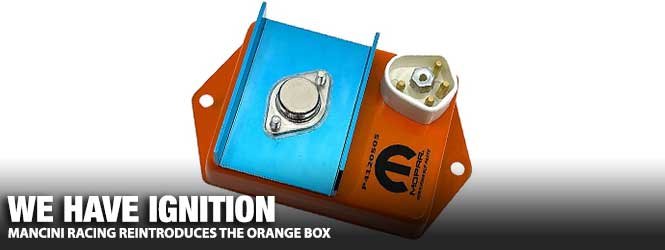
They’re back and Mancini Racing has them. The famous Chrysler electronic ignition controller, the Mopar Performance Orange Box (part no. P4120505), is again available for Mopar enthusiasts. The Orange Box’s performance will rival the units from decades ago because, according to the company’s website, “Mancini Racing went to Mopar’s original supplier to remake the performance Orange Box!”

Above: Mancini Racing has reintroduced the famous Orange Box ignition module. The original supplier provides the four-pin ignition module. Expect the same performance that the initial modules delivered decades ago.
For those who do not know the history of the Chrysler distributor electronic ignition (EI), Chrysler was a leader in the automotive industry regarding solid-state electronics. Whether radios and electronic fuel injection in the ‘50s, or AC generators (alternators) and electronic voltage regulators in the ‘60s, Chrysler was the first manufacturer to incorporate solid-state electronics into its vehicles.
By the early ‘70s, Chrysler had added distributor EI to its list of firsts. With the goal of better fuel economy and cleaner exhaust emissions, Chrysler offered, as an option, a breaker-less distributor, a five-pin ignition box, a dual-ballast resistor, and the related wiring into late-year production ’71 manually shifted (3- or 4-speed) 340 Demons and Dusters.
Left: The first factory ignition module (top) came in three colors based on its rev limiter design. The later modules sold through Direct Connection had a revised connector. An Orange, Chrome (bottom), or Gold box was a great controller for swapping from points to electronic ignition. Right: The factory module (left) has a five-pin design. The Direct Connection unit (right) has only four pins. An internal resistor was added to control the voltage, thus eliminating the need for the fifth pin.
With the success of the EI, Chrysler made the ignition standard in California and an option across the entire V8 line of engines regardless of the transmission in ’72. By ’73, all the engines, including the slant six, had EI installed as standard equipment. Chrysler designed and introduced yet another first. Besides fuel mileage and emissions improvements, there were many benefits of the EI:
• Reduced tune-up intervals
• No parts to wear out/maintenance-free
• No high-rpm misfire concerns
• More spark energy
• Faster cold engine starting
Left: Things are not always what they appear. The mid-70s A-body came with a five-pin controller. However, the owner switched to a four-pin Orange Box. The box was painted black, and an era-correct sticker was applied to the case. Right: Although all four pins of the ballast resistor (white component) appear to be wired, only the low-resistance terminals flow current. The rest of the wires are just for show.
Of course, any Mopar performance devotee could see the benefits of swapping the points ignition for EI. Chrysler also saw the value of the changeover, so through the Direct Connection catalog, Chrysler offered a four-pin ignition module conversion EI. The newer solid-state internals of the four-pin Orange Box provided a more consistent, hotter spark for better performance, which resulted in a rock-solid dwell control to 6000 rpm. Chrysler developed the high-rpm capable Chrome (8000 rpm) and Gold (12,000 rpm) Boxes for the high-winding crowd, but the Orange Box sufficed for most street cars.
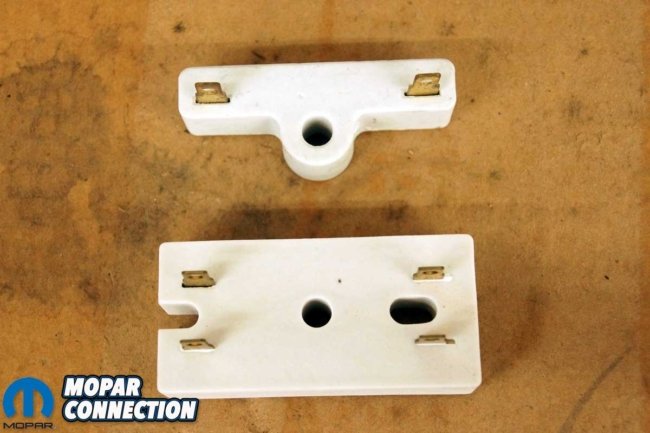
Above: The two-pin ballast resistor is used with the four-pin Orange Box. The four-pin ballast resistor is used with the older, factory five-pin ignition modules.
A four-pin unit is a direct replacement for those with the older five-pin box. However, a five-pin can only replace a four-pin if the vehicle is fitted with a dual-ballast resistor and wiring. A five-pin ignition control module needs two different positive input voltages. In contrast, the four-pin unit only needs one positive input voltage.
Vehicles fitted with a five-pin control module must run a dual-ballast resistor. The dual ballast provides the control module with two voltages. Conversely, a four-pin control module only requires a single-ballast resistor. The single ballast delivers a higher current to the ignition control unit, which offers a lower voltage via a built-in ballast.
Left: To test the factory five-pin module, distributor, and wiring, Chrysler developed the first electronic ignition tester (left). The tester on the right was updated to allow testing of the ballast resistor. Center: Each tester has leads for the battery, distributor, and ignition module. Right: The red or green lights let the person testing know if that part of the circuit passes or fails and, if it fails, which part should be replaced.
With the reintroduction of the Orange Box, it may be time to pick up a spare ignition module or upgrade from that old five-pin module. However, if a points ignition still resides under the hood, check out Mancini’s full array of street, performance package, and race electronic ignitions for LA, B, RB, Hemi and slant six engines. Regardless of what you need, Mancini has you covered.





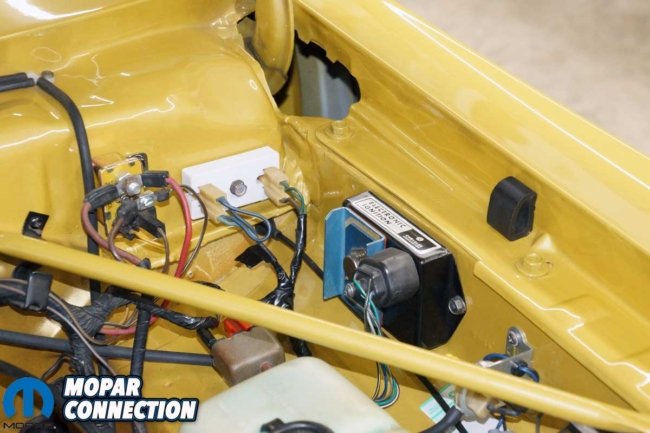
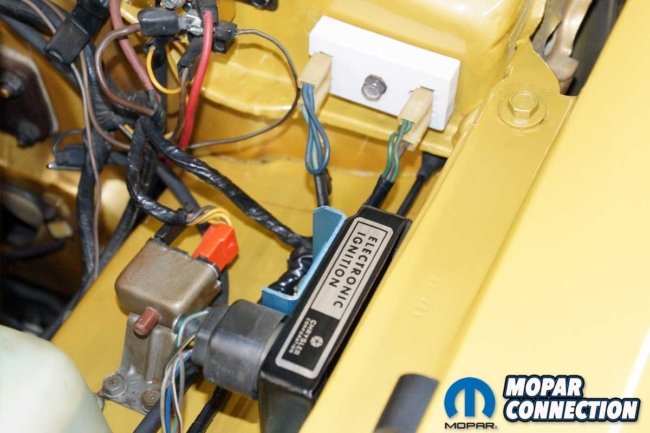


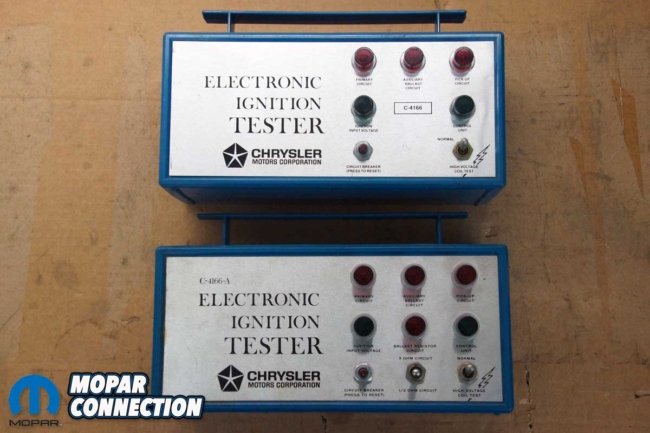








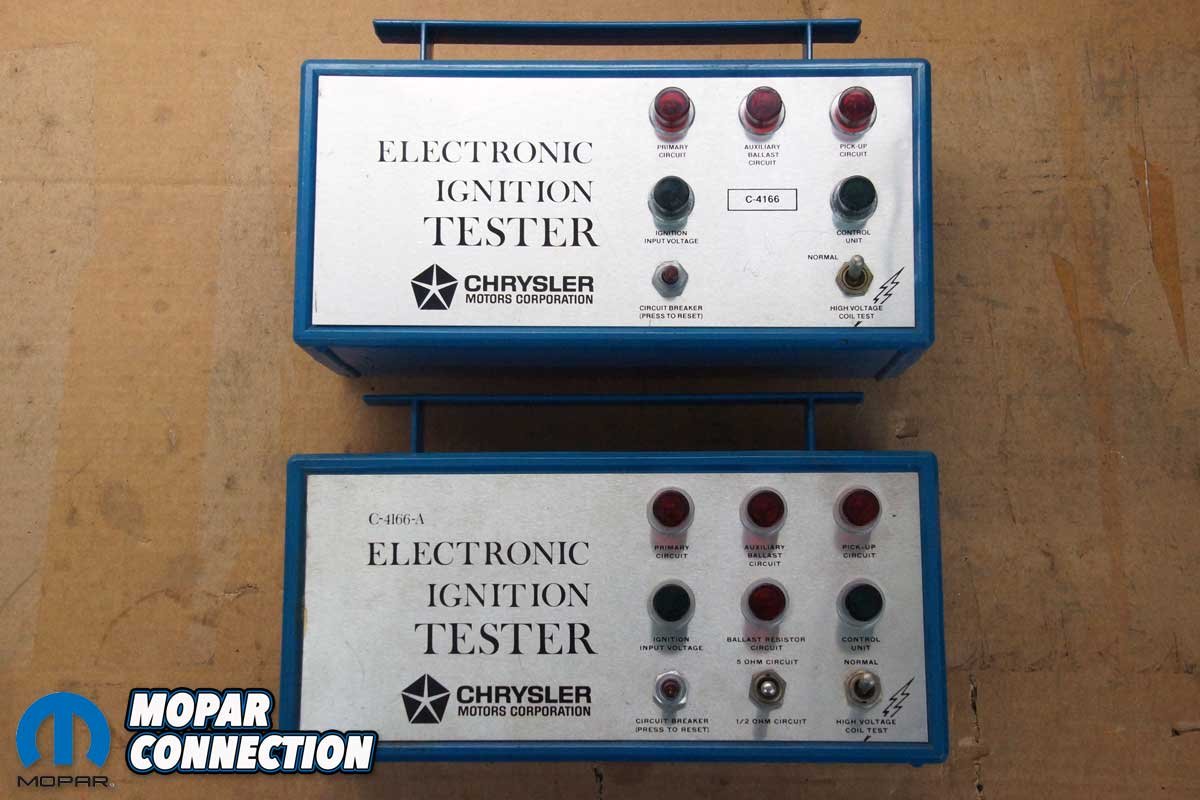





I still have a early 70’s Direct Connection conversion kit that I never installed on my 71 Demon 340, 4 speed. I currently have a Accel dual point distributor in the car. It works fine and still holding the proper dwell. I hate the thought of changing the wiring just to go to the EI.
I could have used this baby last year after purchasing a 69 C body, it died while driving it thru New Hampshire (in the middle of nowhere.) I luckily got a tow to the next town & the mechanic traced the issue to the ignitions “brain” (the orange box…but when we unbolted it, it lacked a pentastar emblem on closer examination…cheap chinese parts…the bane of my existence!) Although the local parts shop actually had a replacement…but painted bronze/gold i think? I’m sure it’s Chinese as well & will eventually leave me on the side of the road & thus will be getting this Mancini one asap…Just as the Mopar electronic ignition I installed in 1999 (w/a real orange box) is still going strong in the 70 Roadrunner (that I converted from points.)
Just wondering. Are these made in the u.s. now?